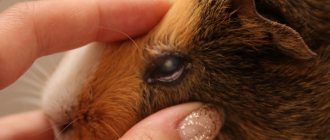Hamsters are popular pets. But, just like all living beings, they get sick and need care. Common diseases include a tumor in a hamster, which can occur in any part of the animal’s body. Under the age of one year, an animal is less susceptible to the appearance of neoplasms, but if your pet is more than two years old, the appearance of oncology is not excluded.
All breeds of hamsters are susceptible to lumps. They come in different sizes and different densities (soft, hard). The lump may cause your pet severe pain or no pain at all.
If a tumor appears on the hamster’s body, you must contact a veterinary clinic for an examination and an accurate diagnosis.
Factors that cause compaction
New growths can be small or huge. According to veterinarians, tumors are more likely to occur in female Djungarian hamsters, which is associated with reproductive characteristics. Males of this species and representatives of other breeds suffer less from this disease.
The reasons that contribute to the appearance of compactions are:
- Fractures or bruises.
- Viral infections.
- Wrong diet.
- The presence of an inflammatory process in the body.
- Congenital pathology.
Depending on the reasons for the appearance of tumors, the types of tumors in hamsters will also be different.
Causes
The causes of tumors can be different. These include bites received during fights, various scratches received when the pet collided with sharp corners of furniture, and other wounds. The cause of the tumor may be poor quality food, improperly removed bedding in the cage, draft or stress. It is necessary to protect them in every possible way from too much noise, from hypothermia, and from aggressive environmental influences.
What to do if you find a tumor in your hamster?
TAKE YOUR HAMSTER TO THE DOCTOR AND DO NOT READ ARTICLES ON THE INTERNET. IT IS IMPORTANT!
If a benign tumor is discovered in a pet, then you can resort to preventive measures; if a malignant tumor is discovered, then you need to resort to measures to remove it. The growth can only be removed through surgery. Professional clinics will create all the conditions for comfortable rehabilitation of your pet, as well as to prevent the recurrence of inflammation.
The sooner the owner contacts the veterinarian, the faster the doctors will remove the tumor, and the pet will suffer less. Painful sensations in hamsters are due to the fact that the wound grows, the skin bursts, and pus cells form ulcers on the body. Very often, the animal, unable to bear the pain, tries to chew off the wound. But such an “operation” will only lead to unnecessary blood loss and, as a result, death.
If a pet develops cancer, then the only measure that should be used in such a situation is amputation. Of course, when it comes to soft tissue tumors, the best outcome is euthanasia.
For the operation, inhalation anesthesia is used, which helps reduce pain during the post-rehabilitation period. It is important to ensure that the rodent does not get hypothermia, otherwise re-infection of the tissues cannot be avoided. During the post-rehabilitation period, you cannot keep your pet on a hungry diet. Otherwise, the wound will heal longer than usual.
It is important to know that after removal of the cancer, the hamster can also die due to the spread of metastases. They can damage internal organs, such as the lungs and liver. Cancer can damage your pet's internal organs. This is evidenced by the curvature of the body.
Types of neoplasms in rodents
Bumps in rodents can appear on the limbs, skin or subcutaneous tissue (external), and internal tumors may also appear (on the uterus, in the intestines). Depending on the etiology, compactions are divided into:
- Benign neoplasms - occur after injuries, viral diseases or are caused by genetic failures. Outwardly, they resemble subcutaneous balls of small sizes and varying densities, which, with light pressure, move to the side. They should be removed to avoid the development of cancer.
- Malignant neoplasms develop either immediately or degenerate from benign ones. The oncological tumor is not localized, metastases spread to different organs of the rodent. Their appearance is provoked by genetic failures, poor nutrition (carcinogenic substances), and viruses.
- Inflammatory processes in tissues are also characterized by swelling, which occurs when pus or lymph accumulates in some areas.
An abscess in a hamster, tissue inflammation or a benign tumor can be treated, but oncology in an animal is incurable.
The difference between a benign tumor and cancer
A malignant lump is usually lumpy and has indistinct edges, unlike a lipoma, which appears as a smooth, spherical formation. Cancerous tissue grows quickly and is prone to ulceration, while wen develops slowly (if it does not grow into deep tissues) and is injured only under external influence.
A fatty cyst is usually soft, while a cancer lump is always hard and elastic.
There are other types of growths that require special attention and treatment to avoid serious complications.
It can be:
- papilloma (wart)
- Tumor
- abscess
- cyst
- hematoma
- mycetoma
- sporotrichosis
What to do if you find a tumor in your hamster?
A lump can appear anywhere in a furry cat, but most often the tumor occurs in the area:
- Necks or heads.
- Belly.
- Paws.
- On the side.
In order to avoid illness in hamsters, it is necessary to frequently examine and feel your furry baby. Oncological diseases in the early stages are almost impossible to detect, but external seals can be diagnosed at home.
Important! First of all, it is necessary to urgently visit a veterinarian who will conduct an examination, take tests, establish a diagnosis and prescribe treatment. Remember that the disease develops quickly in hamsters due to the small size and aggressiveness of the viruses, and sometimes it happens that nothing can be done to help.
How to recognize a wen in an animal
Steatoma differs from other neoplasias in its slow growth and the presence of clear contours. It is mobile and painless. Upon palpation, it is discovered that the seal is not fused to the skin and deep tissues and has a soft dough-like consistency.
Often, palpation reveals fluctuation (a feeling of oscillation), which can be confused with an abscess. If the neoplasm is not burdened by pathological changes, then no subjective sensations are observed in the animal.
However, large growths can lead to changes in the functioning of internal organs and the occurrence of diseases. Sometimes dense areas alternate with soft ones, which also leads to incorrect diagnosis.
An important sign of fat formation is the presence of lobules. The skin in this area does not change color, sometimes it can acquire a yellowish-brown tint.
Clinical signs of lipoma
The location of the cones varies, but if they are located in a vital area, they can pose a serious threat to the health of the animal.
The appearance in the neck area makes breathing difficult, which causes hypoxia to develop. The animal shows signs of depression of the cerebral cortex.
It is noted that:
- lethargic sleepy state
- lethargy
- nausea, vomiting
- urinary and fecal incontinence
If there is a lipoma in the head area, neurological disorders may occur due to compression of the vessels supplying the brain.
The animal is observed:
- change of consciousness
- impaired movement coordination
- convulsions
Severe brain hypoxia leads to the death of the pet.
Lipomas on the paws or armpits lead to lameness and changes in gait.
Neoplasm on the neck
Thickening in the neck of hamsters can be caused by viral or bacterial infections, which lead to inflammation of the animal's lymph nodes. In such cases, Djungarian hamsters may squeak, because the area of inflammation hurts, but not always.
The main symptoms of the disease are loss of appetite due to pain and the inability to turn the head. When you feel the neck under the cheekbones, you will find hard balls - inflamed lymph nodes. A lump on the neck does not affect the life of the rodent, but it causes pain and inconvenience.
Surgical intervention
If a tumor is detected in your pet, you must take a risk and agree to surgical removal. The formations in rodents grow rapidly, the skin cannot withstand it and bursts, forming a fetid, non-healing ulcer. The tumor mass prevents the animal from moving; sometimes the hamsters themselves try to chew off the foreign tissue and die from blood loss. If a limb is affected by cancer, amputation is the best option. If the tumor is on the body, it must be removed while it is still small, otherwise it will be difficult for the surgeon to close the skin defect after removal.
The use of inhalation anesthesia in recent years has increased the survival rate of rodents after surgery. The doctor must have experience working with rodents and ensure that the tiny organism does not become hypothermic during anesthesia. A starvation diet before surgery is not prescribed, and is even harmful.
Removing the tumor itself will not cure the hamster; it will remain sick and may die from tumor metastases to other organs (lungs, liver). But it can improve the quality of life.
If internal organs are affected by cancer, one can only guess about this by the symptoms or asymmetry of the abdomen. In this case, the operation does not make sense and the operation comes down to euthanasia on the surgical table.
Lump on cheek
If an animal has a bump on its cheek that looks like gumboil, this indicates inflammation of the oral cavity, which occurs due to clogging or damage to the cheek pouches with hard, inappropriate food. In the resulting wounds, microbes multiply and provoke severe inflammation, causing swelling on the cheek. The problem is eliminated by visiting a veterinary clinic, where the wounds will be cleaned, disinfected and treated with antibiotics.
If there is a lump on the cheek in the form of a lump under the eye, it is necessary to check the bite, in addition to the cheek pouches. If the teeth are not ground down, malocclusion develops.
Hamster diseases - main symptoms
Any disease in rodents certainly affects their appearance and behavior. A healthy hamster is active, curious, has a good appetite, has well-groomed fur, calm breathing and clear eyes.
Common symptoms include:
- decreased activity
- food refusal
- weight loss
- sniffling, sneezing
- discharge from the eyes and nose
- diarrhea, wet fur around the tail
- hair loss and scratching on the skin
If you notice one of these symptoms of hamster disease, then you need a veterinarian . Visit your doctor as soon as possible.
It is not uncommon for hamsters to develop respiratory infections, which can lead to severe pneumonia (pneumonia). At first, the owner may notice that the hamster is hiding in the house, sneezing, and there is discharge from the eyes and nose. If left untreated, breathing becomes heavier and the hamster may breathe with its mouth open and make wheezing sounds. Pneumonia can lead to death. Early contact with a veterinarian can save your hamster's life.
Lumps on the abdomen
Sometimes neoplasms in rodents appear on the abdomen. In most cases, a tumor on the abdomen appears in mature females in the area of the mammary glands and can be either benign or malignant. Since this growth is not internal, it can be removed.
When examining males, it is necessary to remember that their marker glands are located on the abdomen, which are often confused with a sore. In Djungarian hamsters, the gland is yellowish in color and covered with a crust. Syrians have two of them, they are placed in front of the hind legs symmetrically on both sides and resemble an oval black bald spot.
This is not swelling in the hamster’s abdomen, but an anatomical formation and does not need to be treated. But in order to avoid inflammation or neoplasm in the area of the scent gland, an examination is necessary.
Treatment
Rodents do not tolerate anesthesia well, but if they develop a tumor, they need to be shown to a veterinarian. In any case, surgery increases the chances of a sick pet surviving.
When examining a sick hamster, a veterinarian can make the following decisions:
- If the tumor is small and does not cause concern, do nothing. Advise the animal's owner to adjust the diet in favor of low-calorie food - carrots or cauliflower.
- When an abscess is diagnosed, it is opened, the wound is treated with an antiseptic and treatment is prescribed, mainly with anti-inflammatory ointments, for example, Levomekol.
- If the doctor suspects that a benign tumor has formed, it is removed. Overgrown teeth are filed down.
- In a difficult situation, with a large-scale lesion, the doctor suggests euthanizing the animal.
Other neoplasms
Hamsters are very active animals. Sometimes, if they jump unsuccessfully, they can damage their limbs. Careless handling of your pet can also lead to fractures, dislocations or bruises. If a tumor is detected on the paw, it is necessary to visit a veterinarian and examine the rodent to make sure whether the tumor is caused by an injury or a virus that causes the growth of bone tissue (osteosarcoma).
During the inflammatory process, a purulent cavity may form in the animal. An abscess in a hamster usually appears after fights or other injuries. It is accompanied by redness of the skin and painful sensations, and hair may fall out. At first the tumor is hard, but after the appearance of pus it becomes soft. As a treatment, the abscess must be opened and treated to avoid infection.
How to treat an abscess
An abscess is often mistaken for a tumor - a common purulent neoplasm that arises as a result of infection.
It appears as follows:
- swelling of the affected area;
- deterioration of general condition;
- loss of appetite;
- ugly coat;
- excessive salivation;
- protrusion and purulence of the eyes.
An abscess occurs at the sites of bites, scratches, and wounds. They quickly become infected and the inflammatory process begins. If you notice one of the listed symptoms and find that there is wet fur and pus at the site of the injury, then you should immediately go to the veterinary clinic. The doctor will assess the condition of the problem. If it is at an early stage, then you can get by with regular rinsing and antibiotics. If the wound is already opening, then you will have to open it, disinfect it and apply an antiseptic (Fitoelita, Levomekol). As a last resort - surgical intervention.
Find out what to do if your hamster breaks its leg.











